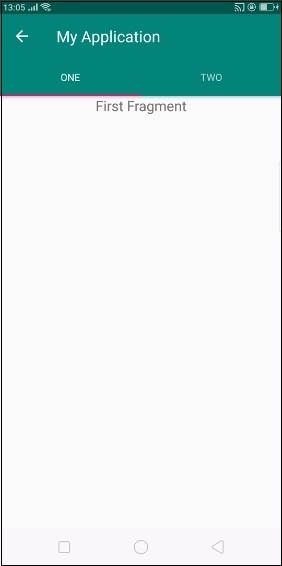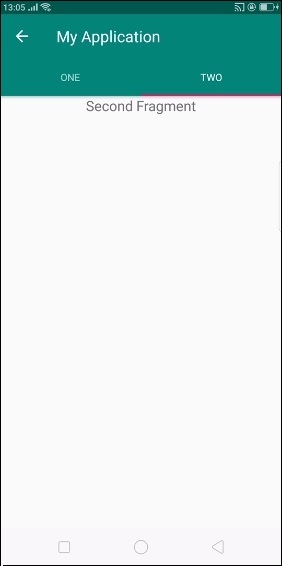
 Data Structure
Data Structure Networking
Networking RDBMS
RDBMS Operating System
Operating System Java
Java MS Excel
MS Excel iOS
iOS HTML
HTML CSS
CSS Android
Android Python
Python C Programming
C Programming C++
C++ C#
C# MongoDB
MongoDB MySQL
MySQL Javascript
Javascript PHP
PHP
- Selected Reading
- UPSC IAS Exams Notes
- Developer's Best Practices
- Questions and Answers
- Effective Resume Writing
- HR Interview Questions
- Computer Glossary
- Who is Who
How to use Android ViewPager?
Before getting into the example, we should know what is view pager in android. View pager found in Support Library in Android, using view pager we can switch the fragments.
This example demonstrates how to use android view pager.
Step 1 − Create a new project in Android Studio, go to File ⇒ New Project and fill all required details to create a new project.
Step 2 − Add the following code in build.gradle.
apply plugin: 'com.android.application'
android {
compileSdkVersion 28
defaultConfig {
applicationId "com.example.andy.myapplication"
minSdkVersion 19
targetSdkVersion 28
versionCode 1
versionName "1.0"
testInstrumentationRunner "android.support.test.runner.AndroidJUnitRunner"
}
buildTypes {
release {
minifyEnabled false
proguardFiles getDefaultProguardFile('proguard-android.txt'), 'proguard-rules.pro'
}
}
}
dependencies {
implementation fileTree(dir: 'libs', include: ['*.jar'])
implementation 'com.android.support:appcompat-v7:28.0.0'
implementation 'com.android.support:design:28.0.0'
implementation 'com.android.support.constraint:constraint-layout:1.1.3'
testImplementation 'junit:junit:4.12'
androidTestImplementation 'com.android.support.test:runner:1.0.2'
androidTestImplementation 'com.android.support.test.espresso:espresso-core:3.0.2'
}
Step 3 − Add the following code to res/layout/activity_main.xml.
<?xml version = "1.0" encoding = "utf-8"?> <android.support.design.widget.CoordinatorLayout xmlns:android = "http://schemas.android.com/apk/res/android" xmlns:app = "http://schemas.android.com/apk/res-auto" android:layout_width = "match_parent" android:layout_height = "match_parent"> <android.support.design.widget.AppBarLayout android:layout_width = "match_parent" android:layout_height = "wrap_content" android:theme = "@style/ThemeOverlay.AppCompat.Dark.ActionBar"> <android.support.v7.widget.Toolbar android:id = "@+id/toolbar" android:layout_width = "match_parent" android:layout_height = "?attr/actionBarSize" android:background = "?attr/colorPrimary" app:layout_scrollFlags = "scroll|enterAlways" app:popupTheme = "@style/ThemeOverlay.AppCompat.Light" /> <android.support.design.widget.TabLayout android:id = "@+id/tabs" android:layout_width = "match_parent" android:layout_height = "wrap_content" app:tabMode = "fixed" app:tabGravity = "fill"/> </android.support.design.widget.AppBarLayout> <android.support.v4.view.ViewPager android:id = "@+id/viewpager" android:layout_width = "match_parent" android:layout_height = "match_parent" app:layout_behavior = "@string/appbar_scrolling_view_behavior" /> </android.support.design.widget.CoordinatorLayout>
Step 4 − Add the following code to src/MainActivity.java
package com.example.andy.myapplication;
import android.annotation.TargetApi;
import android.os.Build;
import android.os.Bundle;
import android.support.design.widget.TabLayout;
import android.support.v4.app.Fragment;
import android.support.v4.app.FragmentManager;
import android.support.v4.app.FragmentPagerAdapter;
import android.support.v4.view.ViewPager;
import android.support.v7.app.AppCompatActivity;
import android.support.v7.widget.Toolbar;
import java.util.ArrayList;
import java.util.List;
public class MainActivity extends AppCompatActivity {
private ViewPager viewPager;
private Toolbar toolbar;
private TabLayout tabLayout;
@TargetApi(Build.VERSION_CODES.O)
@Override
protected void onCreate(Bundle savedInstanceState) {
super.onCreate(savedInstanceState);
setContentView(R.layout.activity_main);
toolbar = (Toolbar) findViewById(R.id.toolbar);
setSupportActionBar(toolbar);
getSupportActionBar().setDisplayHomeAsUpEnabled(true);
tabLayout = findViewById(R.id.tabs);
viewPager = findViewById(R.id.viewpager);
ViewPagerAdapter adapter = new ViewPagerAdapter(getSupportFragmentManager());
adapter.addFragment(new OneFragment(), "ONE");
adapter.addFragment(new TwoFragment(), "TWO");
viewPager.setAdapter(adapter);
tabLayout.setupWithViewPager(viewPager);
}
class ViewPagerAdapter extends FragmentPagerAdapter {
private final List<Fragment> mList = new ArrayList<>();
private final List<String> mTitleList = new ArrayList<>();
public ViewPagerAdapter(FragmentManager supportFragmentManager) {
super(supportFragmentManager);
}
@Override
public Fragment getItem(int i) {
return mList.get(i);
}
@Override
public int getCount() {
return mList.size();
}
public void addFragment(Fragment fragment, String title) {
mList.add(fragment);
mTitleList.add(title);
}
@Override
public CharSequence getPageTitle(int position) {
return mTitleList.get(position);
}
}
}
Step 5 − Add the following code to src/OneFragment.java
package com.example.andy.myapplication;
import android.os.Bundle;
import android.support.v4.app.Fragment;
import android.view.LayoutInflater;
import android.view.View;
import android.view.ViewGroup;
import android.widget.TextView;
public class OneFragment extends Fragment {
@Override
public View onCreateView(LayoutInflater inflater, ViewGroup container, Bundle savedInstanceState){
View v= inflater.inflate(R.layout.fragment_one, container, false);
TextView textView=v.findViewById(R.id.text);
textView.setText("First Fragment");
return v;
}
}
Step 6 − Add the following code to src/TwoFragment.java
package com.example.andy.myapplication;
import android.os.Bundle;
import android.support.v4.app.Fragment;
import android.view.LayoutInflater;
import android.view.View;
import android.view.ViewGroup;
import android.widget.TextView;
public class TwoFragment extends Fragment {
@Override
public View onCreateView(LayoutInflater inflater, ViewGroup container, Bundle savedInstanceState){
View v= inflater.inflate(R.layout.fragment_one, container, false);
TextView textView=v.findViewById(R.id.text);
textView.setText("Second Fragment");
return v;
}
}
Step 7 − Add the following code to res/layout/fragment_one.xml.
<?xml version="1.0" encoding="utf-8"?> <LinearLayout xmlns:android="http://schemas.android.com/apk/res/android" android:layout_width="match_parent" android:layout_height="match_parent"> <TextView android:id="@+id/text" android:layout_width="match_parent" android:layout_height="wrap_content" android:gravity="center" android:textSize="20sp" /> </LinearLayout>
Step 8 − Add the following code to styles.xml.
<resources> <!-- Base application theme. --> <style name="AppTheme" parent="Theme.AppCompat.Light.DarkActionBar"> <!-- Customize your theme here. --> <item name = "windowNoTitle">true</item> <item name = "windowActionBar">false</item> <item name="colorPrimary">@color/colorPrimary</item> <item name="colorPrimaryDark">@color/colorPrimaryDark</item> <item name="colorAccent">@color/colorAccent</item> </style> </resources>
Let's try to run your application. I assume you have connected your actual Android Mobile device with your computer. To run the app from android studio, open one of your project's activity files and click Run ![]() icon from the toolbar. Select your mobile device as an option and then check your mobile device which will display your default screen −
icon from the toolbar. Select your mobile device as an option and then check your mobile device which will display your default screen −


Click here to download the project code

